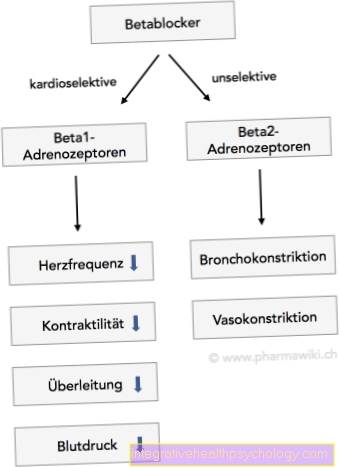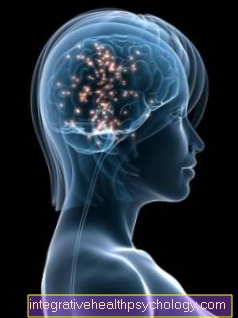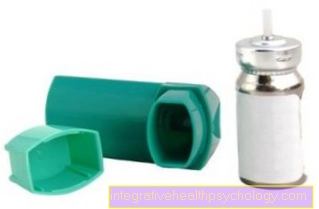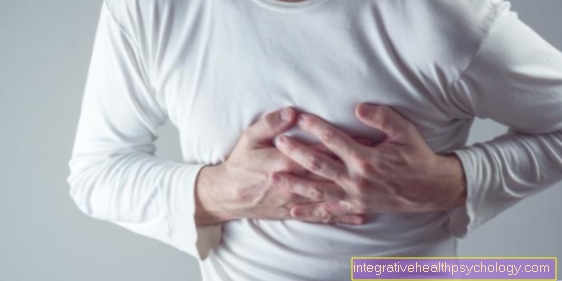Breast cancer pain
introduction
Most breast tumors do not cause pain in the early stages of the disease and are therefore diagnosed relatively late. For this reason, regular breast cancer check-ups are important in order to be able to detect and treat breast cancer early. Pain that radiates to the armpit, shoulder and back is mostly caused by metastatic tumor cells, which means that the disease has already spread in the body and is more advanced. Most of the time, breast pain is not a sign of breast cancer, but rather has harmless causes.

What breast pains can be a sign of breast cancer?
A tumor in the breast usually doesn't cause pain. Pain can only occur in the more advanced stage of the cancer. Usually it is stabbing or burning pain. The pain can not only occur in the chest, but also radiate to the armpit, arm or back. In most cases, breast pain has other, often harmless causes, e.g. Fluid-filled cysts that press on the surrounding tissue or the breasts stretch before menstruation due to hormones.
Inflammatory breast cancer is a special form of breast cancer that causes burning pain in the chest. In addition, there are typical signs of inflammation: the mammary gland tissue is swollen, the breast is warm and reddened. In this disease, the tumor cells spread quickly via the lymphatic system in the body, this form of spread is called Lymphangiosis carcinomatosa designated. Inflammatory breast cancer is very rare, but it is the most aggressive form of breast cancer and accordingly has a poor prognosis.
Read more about this under What types of breast cancer are there? as well as signs of breast cancer
Can arm pain be a sign of breast cancer?
Arm pain can be a sign of breast cancer. There are many lymph nodes in the armpit, which in breast cancer are often palpably enlarged and cause pain. This pain can radiate from the armpit to the entire arm. In addition, there may be swelling in the arm on the affected side.
Often the pain in the arm also has other causes. Problems in the shoulder joint or muscle tension can cause pulling pains in the upper arm. Nerve irritation is often responsible for the pain in the arm. If the pain is unclear and a serious illness is suspected, you should always consult a doctor to clarify the symptoms.Breast cancer in particular has a relatively favorable prognosis if it is diagnosed early and therapy is started immediately.
Pain in the armpit
Lymph nodes are located in the armpit, into which lymph drains from the breasts. If you have cancer of the breast, the lymph nodes in the armpit on the affected side are usually enlarged and swollen, causing pain. Palpable lumps in the armpits can cause pain and are often an indication of breast cancer.
Read about this too Lymph node swelling in the armpit - how dangerous is it?
Shoulder pain
Many patients report shoulder pain even before breast cancer was diagnosed. The pain occurs between the shoulder blades in the upper back area and can be an early symptom of breast cancer.
Pain in the ribs
At an advanced stage, tumor cells can become detached from the breast cancer (Metastasis) and affect the surrounding tissues. Metastases often form in the spine and ribs. The patients describe the resulting bone pain as acute or pressing.
Pain in the lymph nodes
The lymph nodes into which lymph drains from the breasts are in the armpit, next to the chest muscle and above the collarbone. Pain and swelling in the lymph nodes can indicate breast cancer and lymph node metastases. In many cases, however, the painful lymph nodes are caused by an infection or inflammation in the body.
You might also be interested in this topic: Benign breast tumors
Back pain
Breast cancer has different signs. In addition to palpable lumps, changes in the nipple, and chest pain, chronic back pain can also be a sign of breast cancer.
Especially in the early stages, the tumor disease sometimes makes itself noticeable through pain between the shoulder blades. In the advanced stage, metastases can form, which affect the spine and lead to bone pain there.
More on this: Metastases in breast cancer
Pain in the nipple
Changes in the nipple are often a sign of breast cancer. In most cases, however, painful nipples have harmless causes, such as inflammation of the mammary gland or stress.
However, if there are other symptoms of retraction or the discharge of bloody secretions from the nipple, a doctor should be consulted.
You may also be interested in this topic: Inflammation of the nipple
What pain does one have after having breast cancer surgery?
The modern methods of surgical tumor removal in breast cancer are relatively gentle and nowadays, in most cases, the entire breast no longer has to be removed. The pain after the operation depends on the particular surgical method. In addition to breast-conserving surgery, in which only the tumor tissue and healthy tissue are removed with a certain safety margin, there is also the option of complete breast removal (Mastectomy). A mastectomy is a larger procedure than the breast-conserving method and is therefore more painful. In the past, the mastectomy used to remove the entire chest muscle, which meant that the pain after the operation was relatively severe. Today there are more modern methods that allow only the mammary gland tissue to be removed and the pectoral muscle to be preserved.
Read more about this under
- Surgery for breast cancer
- Mastectomy
During most breast cancer operations, the so-called "Guardian lymph nodes“In the armpit is removed by default in order to remove as many tumor cells as possible. Many women develop chronic chest pain after the operation - especially if lymph nodes have also been removed. The cause of this pain has not yet been fully clarified; the missing lymph nodes probably play a role.
Most patients decide to have a breast augmentation with implants after breast removal. This is a minor, routine procedure that can still cause severe pain. In rare cases the silicone implants become encapsulated and very painful complications occur.
Read more about this under Breast reconstruction
What kind of pain occurs during chemotherapy
The pain that occurs during chemotherapy for the treatment of breast cancer depends primarily on the drugs used and their dose. Most cytostatics are not specifically directed against cancer cells, but generally disrupt the cell division of rapidly growing cells and thereby inhibit their spread. In addition to tumor cells, the rapidly growing cells also include cells from the bone marrow and mucous membranes, and the side effects are correspondingly wide. The damage to healthy tissue can sometimes cause severe pain, although the individual situation depends on the patient. Above all, damage to the mucous membranes in the gastrointestinal tract causes diarrhea, vomiting and pain. Mucous membrane problems caused by chemotherapy are less common in breast cancer patients than in other types of cancer.
Some substances that are used in chemotherapy can also cause nerve damage. The patients then have side effects such as tingling or abnormal sensations even after the treatment is completed. But nerve pain, which is characterized by a surge-like electrical pain, can also occur.
Read more about this under Chemotherapy side effects
What pain can be expected with radiation?
Radiation therapy uses X-rays that penetrate the chest and destroy the tumor cells there. The patient does not feel the radiation itself and initially it does not cause any pain. As the radiation kills healthy tissue as well as cancer cells, side effects and pain can occur after the treatment. The extent of pain caused by radiation therapy for breast cancer therapy depends heavily on the general condition of the patient and the size of the tumor. In addition, the level of the individual and total dose administered plays an important role in the occurrence of side effects.
The radiation can cause the breast to swell and become hot. Sometimes the skin also has to be irradiated, which can result in slight burns and reddening of the skin (similar to sunburn), which will quickly disappear after the therapy is completed. Even days after the treatment, you may experience severe chest pain that is stinging and burning to the touch.
An effective method of irradiating breast cancer is so-called "pecking" the breast. Small catheters are inserted into the chest, through which the tumor is then irradiated with pinpoint accuracy. Of course, pain is caused by the small wounds that occur when the chest is punctured, but this method sounds more painful than it actually is.
Read more about this under Irradiation for breast cancer





























